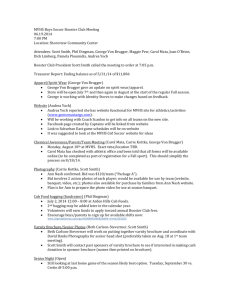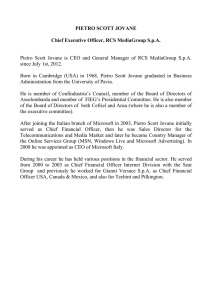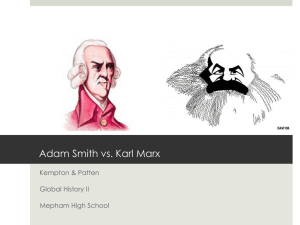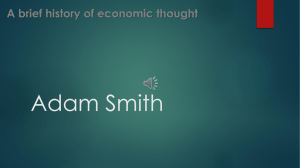File
advertisement
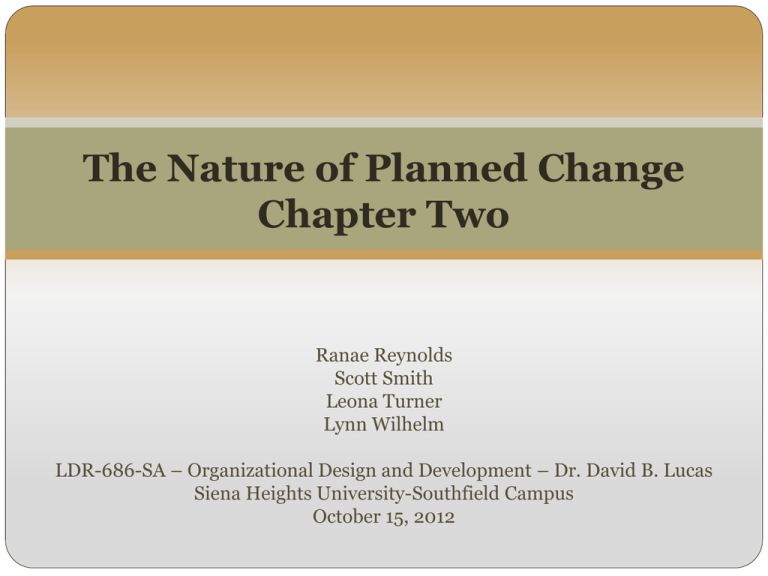
The Nature of Planned Change Chapter Two Ranae Reynolds Scott Smith Leona Turner Lynn Wilhelm LDR-686-SA – Organizational Design and Development – Dr. David B. Lucas Siena Heights University-Southfield Campus October 15, 2012 is inevitable! Lynn Wilhelm Lewin’s Change Model Lynn Wilhelm Action Research Model Lynn Wilhelm The Positive Model Lynn Wilhelm Comparison of Change Models Overlap in various ways Lewin’s focuses on how to fix problems All others focus on what the organization does well and leverages those strengths Lynn Wilhelm The General Model of Planned Change Ranae Reynolds Entering and Contracting Entering Phase involves gathering information from the organization to understand the problems or to determine the positive areas for inquiry. Contracting Phase spells out the changes that will proceed for the future, the resources that will be used and how everyone will be involved. Ranae Reynolds Diagnosing Central change Activities Gathering Analyzing Feedback Ranae Reynolds Planning and Implementing Change Human process interventions at the individual, group, and total system levels; Interventions that modify an organization’s structure and technology; Human resources interventions that seek to improve member performance and wellness; Strategic interventions that involve managing the organization's relationship to its external environment and the internal structure and process necessary to support a business strategy. Ranae Reynolds Evaluating and Institutionalizing Change Evaluating Change requires feedback about whether changes should be continued, modified, or suspended. Institutionalizing Change requires reinforcement through feedback, rewards and training. Ranae Reynolds General Model of Planned Change Entering and Contracting Diagnosing Planning and Implementing Change Evaluating and Institutionalizing Change Leona Turner Planned Change What is planned change? Planned change can vary enormously from one situation to another. Why? Can be contrasted across situations along three dimensions. Leona Turner Key Dimensions of Planned Change Magnitude of Change The degree to which the client system is organized The setting-domestic or international Leona Turner Magnitude of Change Planned change efforts range from incremental to fundamental. OD practitioners are usually contacted by managers for specific problems. Diagnostic and change activities are limited to defined issues. Leona Turner Incremental Changes Involves limited dimensions and levels of the organization Occur within the context of the organization’s existing business areas. Aimed at improving the status quo Leona Turner Fundamental Change Directed at significantly altering how the organization operates. Involve several organizational dimensions. Involve changing multiple levels of the organization. Leona Turner Chapter 2 Topics Domestic vs. International Settings Critique of Planned Change Conceptualization Practice IMAR Planned Change in an Under- Organized System Scott Smith Domestic vs. International Domestic (NA & EU) Equality Involvement Short time horizons International (APA) Hierarchical Status Avoid personal Save face Long time horizons Scott Smith Domestic vs. International Action Research Process (ARP) recommended Cyclical Joint activities between organization members Multiple steps that overlap Problem identification Consult with behavioral science expert Data gathering and diagnosis Feedback Scott Smith Domestic vs. International ARP adapted to fit cultural context Many organizational members Execs only Top-down Inside vs. outside consultants Face-to-face interviews Scott Smith Domestic vs. International OD Practitioner must: Aware of own cultural biases See issues from another perspective Fluent in values and assumptions of country Understand economic and political context Vacations Time zones Cultural Guide recommended Scott Smith Domestic vs. International Tyler Lacoma Virtual Organizations – Time and Distance A business model that supports Online collaboration applications (audio and video conferencing) Employees are able to use mobile technology and home offices to overcome the barriers that time difference presents. Scott Smith Domestic vs. International Chacar, Celo and Thams Synergies of Domestic Companies with MNCs Advantages Scale Existing resources Disadvantages “Foreignness” China / Japan island dispute Culture Required (JVs) Scott Smith Conceptualization of Planned Change Critique Must identify organizational features that can be changed Intended outcomes from changes Mechanisms by which change is achieved Contingencies on which change depends Scott Smith Conceptualization of Planned Change Critique (cont). Contingencies Stages differ across situations Magnitude Client system organization Domestic or international Intuitive? Scott Smith Conceptualization of Planned Change Critique (cont). Not rational or orderly, but chaotic Shifting goals Discontinuous activities Surprising events Unexpected combinations Overzealous testimonials Change never ends Scott Smith Practice of Planned Change Critique Specialized OD practitioners (TQM, AI, Group) results in inappropriate method usage (diversity, reengineering, self-managing teams) “Cart-before-the-horse” Self-diagnosis and action plans Quick-fix instead of required long-term plan Sub-optimization Scott Smith Institute for Manufacturing and Automation Research (IMAR) Case Study So how does IMAR rate? Strong leader and vision (Dale Hartman, Hughes) Basic research (non-competitive) Oversight (board, NSF, co-directors) Strong industry-university partnership 5-year self-sustaining requirement (no NSF) Committed funding Audits, project team oversight Scott Smith Thibault Fally on International vs. Domestic Production Fragmentation: Scott Smith Resources Bauer, T., (2011). Berrin erdogan source: flat world knowledge. Retrieved October 10, 2012 from http://www.peoi.org/Courses/Coursesen/orgbeh1/contents/frame14b.html Chacar, Aya S., Celo, Sokol, and Thams, Yannick. (2010). The performance of multinational affiliates versus domestic firms. Retrieved on October 4, 2012 from http://www.nabusinesspress.com/JMPP/ChacarWeb.pdf Cummings, T., and Worley, C.,(2009).Organization development and change. Thomson/South-Western, Ohio Fally, Thibault. (January 10, 2012). Has production become more fragmented? International vs. domestic perspectives. Retrieved on October 8, 2012 from http://www.voxeu.org/article/has-productionbecome-more-fragmented-international-vs-domestic- perspectives Lacoma, Tyler. Changing organizational structure when going global. Retrieved on October 8, 2012 from http://www.ehow.com/info_8456366_changing-organizational-structure-going-global.html
